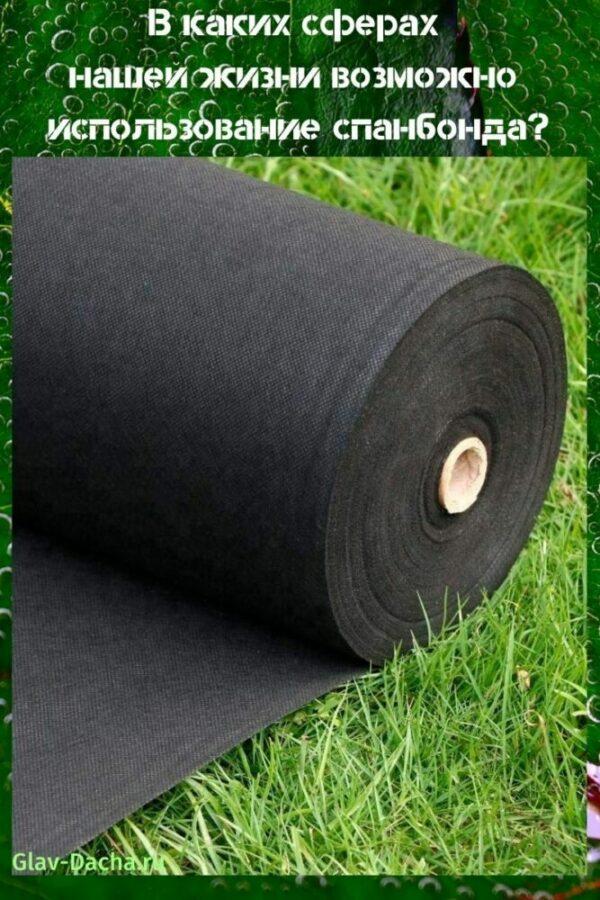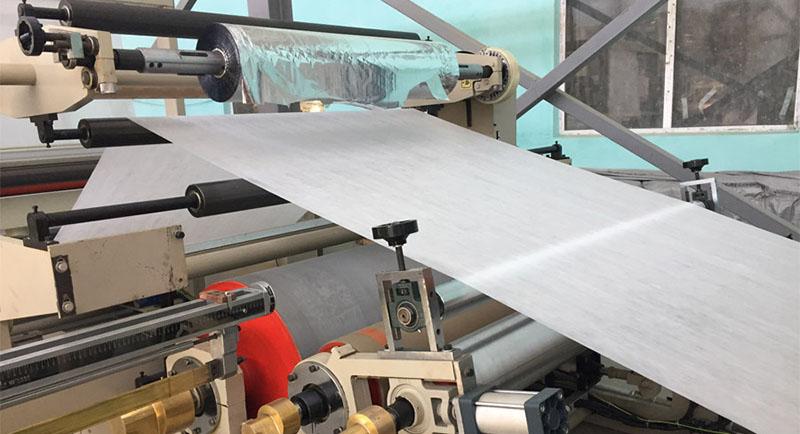In what areas of our life is it possible to use spunbond?
 Spunbond is a non-woven polymer fiber used as a covering material in agriculture. Despite the fact that this material has appeared relatively recently, it has become extremely popular among gardeners, gardeners and summer residents. After all, the use of spunbond provides reliable protection of garden and vegetable crops from adverse weather conditions.
Spunbond is a non-woven polymer fiber used as a covering material in agriculture. Despite the fact that this material has appeared relatively recently, it has become extremely popular among gardeners, gardeners and summer residents. After all, the use of spunbond provides reliable protection of garden and vegetable crops from adverse weather conditions.
What is spunbond

As a result of heating polypropylene to a high temperature, the material is separated into hundreds of thousands of microscopic fibers, which are combined with each other in the process of thermal bonding. The result is the most durable polymer web with a nonwoven structure.
Spunbond characteristics depending on material composition:
- Low weight of covering material - regardless of what spunbond is made of, this material is very light and does not exert stress on sheltered crops, beds and greenhouses.
- Spunbond can be additionally covered with special light stabilizers to protect it from ultraviolet rays.
- Spunbond is an environmentally friendly material that does not emit toxic substances and is excellent for sheltering garden and fruit crops.
- The material is highly resistant to various external factors. Even under the influence of sudden temperature changes and precipitation, it does not rot, mold, and is not affected by fungal microorganisms, insects and rodents.
- Moisture permeability and ventilation - Spunbond perfectly permeates oxygen, providing air exchange required for full growth and development of crops.
- Sufficient level of light transmission - all types of spunbond to one degree or another transmit sunlight. This creates favorable conditions for the development and fruiting of plants.
Spunbond in agriculture is most often used as a covering material. This tightly reliably protects the plants from the scorching sun rays and does not allow them to freeze during the frost period.
Features of production
 In the production of the covering material, the spinneret method is used, which makes it possible to make a cloth from molten polymers without a loom. For this, liquid polypropylene is passed through spinning nozzles. As a result, yarns or fibers are obtained.
In the production of the covering material, the spinneret method is used, which makes it possible to make a cloth from molten polymers without a loom. For this, liquid polypropylene is passed through spinning nozzles. As a result, yarns or fibers are obtained.
 After that, polypropylene fibers or threads are laid out on a special conveyor to form a web. To impart integrity to the covering material, various methods are used - the use of chemical impregnation, thermal bonding or needle punching. The most popular and widespread technology is thermal bonding, in which the material is passed through rotating shafts to which hot air flows are supplied to ensure fast and reliable bonding of the elements.
After that, polypropylene fibers or threads are laid out on a special conveyor to form a web. To impart integrity to the covering material, various methods are used - the use of chemical impregnation, thermal bonding or needle punching. The most popular and widespread technology is thermal bonding, in which the material is passed through rotating shafts to which hot air flows are supplied to ensure fast and reliable bonding of the elements.
Varieties of spunbond

The scope of use of spunbond depends on the type of polypropylene synthetic material. They differ depending on the composition and conditions of use:
- Agrofibre is the most common type of spunbond used in agriculture. The material is additionally processed with photostabilizers, which ensure high resistance to UV light.

- Reinforced spunbond - designed for use in greenhouses and arranging greenhouses.

- Colored spunbond - it is characterized by increased strength and decorativeness, due to which it is used both in plant growing and in everyday life (for sewing bags, clothes and other products). It is used for covering plants and mulching the soil.

- Laminated - many summer residents are interested in what it is, laminated spunbond. It is a waterproof and airtight material that has a dense, smooth side. It is used in the medical field.

The most common type is practical and durable agrofibre. When using a spunbond, keep in mind that it comes in black and white. The first is for mulching flower beds and vegetable beds, as it retains moisture and nutrients well in the soil. White spunbond is used to protect plantings from sunlight.
The use of spunbond in agriculture
 The use of spunbond in the country is possible in several ways. It is often used in the arrangement of greenhouses and greenhouses, since such material is much more profitable and cheaper than the usual tiles.
The use of spunbond in the country is possible in several ways. It is often used in the arrangement of greenhouses and greenhouses, since such material is much more profitable and cheaper than the usual tiles.
The main ways to use spunbond on dacha:
- Accelerated heating of the soil before early maturing spring plantings. Covering the beds with agrofibre stimulates the appearance of the first shoots and young shoots.
- Protection of garden, fruit and berry and ornamental crops from return frosts.

- The use of weed control spunbond helps to stop the growth of weeds and makes it easier to maintain garden and horticultural crops.
- Protection of crops and young seedlings from insect pests, birds and rodents.

- Maintaining the optimal level of moisture in the upper layers of the soil, preventing it from drying out.
- Protection against various adverse weather conditions - wind, heavy rain, hail and snow.

Spunbond is used both in open beds and in greenhouses. This material is able to pass air currents without creating a condensation effect. Under such a shelter, plants do not suffer from excess moisture.
The use of non-woven material helps to increase the yield of the soil, protects plants from the development of gray rot, and prevents the growth of weeds in beds with strawberries, raspberries and blackberries. This shelter has a long service life, it can be used for several seasons - this does not affect its properties in any way.
In agriculture, spunbond with a density of 20-80 g / m² is used, both white and colored. The two-color material must be placed with the black side down to stop the growth of weeds, and the white coating reflects ultraviolet rays.
 The use of spunbond is light and simple, but this material, like any other, can be damaged or torn. There are several ways how to connect spunbond together. Pieces of agrofibre can be sewn with thick, coarse threads (preferably 2 rows). Connect with a special construction stapler gun, placing a strip of dense material under the bonding point.
The use of spunbond is light and simple, but this material, like any other, can be damaged or torn. There are several ways how to connect spunbond together. Pieces of agrofibre can be sewn with thick, coarse threads (preferably 2 rows). Connect with a special construction stapler gun, placing a strip of dense material under the bonding point.
Spunbond in construction
 In the construction industry, spunbond is used as an insulating material. Various membranes are made from dense fiber. They are laid as an intermediate layer between the walls and the finish to prevent cracking.
In the construction industry, spunbond is used as an insulating material. Various membranes are made from dense fiber. They are laid as an intermediate layer between the walls and the finish to prevent cracking.
Polypropylene material is widely used in the field of landscape design - it is laid under the drainage layer when arranging roads, alleys, alpine hills, gardens and park areas.
Using spunbond in everyday life
 In the household sphere, spunbond is used for sewing workwear, disposable kits and products - medical gowns, masks, hats, shoe covers. Polypropylene material lends itself well to sterilization, repels moisture and maintains normal air exchange.
In the household sphere, spunbond is used for sewing workwear, disposable kits and products - medical gowns, masks, hats, shoe covers. Polypropylene material lends itself well to sterilization, repels moisture and maintains normal air exchange.
Also, spunbond is often sewn:
- kitchen aprons;
- work suits and protective gloves;
- lining in outerwear, bags, wallets and suitcases.
Non-woven material is used in the manufacture of many products:
- sofas and upholstery;
- mattresses;

- souvenir cases and covers;
- filters for various devices;
- cases and organizers;
- covers for clothes.
Spunbond is a nonwoven covering material that is used in many applications. It will be a good help for farmers and summer residents in the cultivation of garden and horticultural crops, facilitating the care of plants and increasing the yield of the soil. Also, polypropylene spunbond is used in the manufacture of bags, furniture and accessories, medical products and workwear.